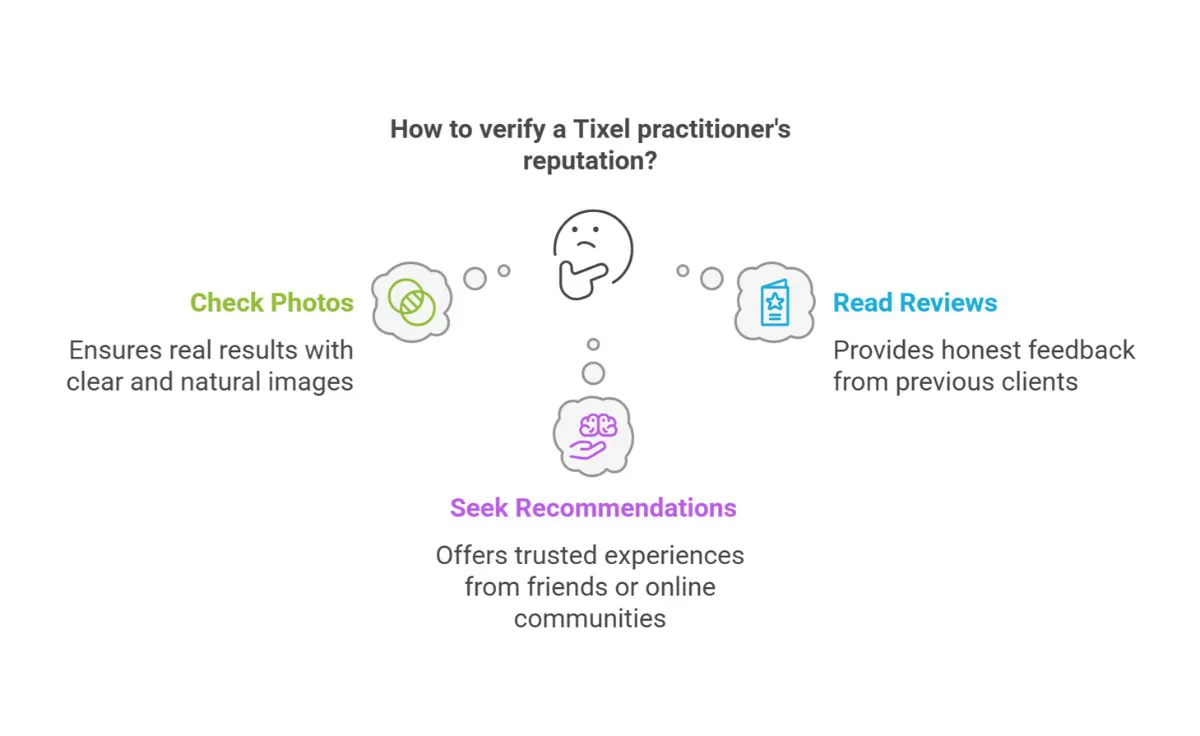Imagine walking into a clinic, excited for your Tixel treatment, only to feel uneasy about the practitioner's lack of answers to your questions. What if they’re not as qualified as you thought? Or worse, what if you’re not getting the promised results? Your skin deserves the best care, so how can you tell if a Tixel practitioner is really right for you?
Choosing the right Tixel practitioner isn’t just about booking an appointment—it's about ensuring your skin gets the care it deserves. Too often, people jump into treatments without asking the important questions and end up disappointed with the results.
Many people trust their skin to practitioners who lack the right qualifications or aren’t transparent about their treatment plans. This can lead to poor outcomes, wasted money, and even lasting skin issues.
When it comes to Tixel treatments, rushing the process can have serious consequences. Your skin is one of your most valuable assets, and trusting the wrong person can undo your progress. Are you really ready to take that risk?
In this guide, we’ll explore key questions to ask before booking, the red flags to watch for, and how to verify a practitioner's reputation to ensure you’re in safe hands. With this information, you’ll feel confident, informed, and ready to enjoy the full benefits of Tixel—without any surprises.
You wouldn’t let just anyone cut your hair, right? So why trust just anyone with your skin? Choosing a Tixel provider is like picking a pilot—you need someone who knows exactly what they’re doing because there’s no “undo” button for your face.
Not every aesthetician is trained in Tixel. In fact, many aren’t. The ideal provider should be:
Would you go skydiving with an instructor who’s never jumped before? Same logic applies here. Ask:
A seasoned pro can adjust settings on the fly, spot potential risks, and know exactly how much heat your skin can handle before irritation kicks in.
Tixel isn’t a “plug and play” device. Settings must be fine-tuned based on your skin’s thickness, sensitivity, and pigmentation. If a provider uses the same settings for every patient? Run.
Trusting someone with your skin is a big deal, right? It's like picking a doctor. But how do you know if a Tixel practitioner is actually good at what they do? You wouldn’t just go to any mechanic to fix your car, would you? Here’s how to make sure you’re in safe hands.
Before you book, ask to see real, unfiltered before-and-after photos. Don’t just settle for what’s on their website. Look for:
Next, dive into online reviews. Trust me, if a Tixel practitioner is good, their patients will rave about them. Check:
Word of mouth works wonders! Ask around:

Booking your Tixel treatment? Hold up! Don't just book on a whim. It's like making a decision on a new car— you need to ask the right questions first! Let’s dive into the must-ask questions to ensure you’re getting top-notch care and the results you're hoping for.
First things first: Safety. You’re trusting someone with your skin—this is no small matter. Ask these questions to ensure everything is being done properly:
Tixel is not a one-size-fits-all treatment. A good practitioner should adjust the settings for your unique skin needs.
You don’t want to be blindsided by the cost or underwhelmed by the results. Be clear:
You wouldn’t let just anyone operate on your car, right? The same goes for your skin. There are a few red flags you should watch out for when selecting a Tixel practitioner. Let’s dive into these warning signs so you can avoid potential mishaps!
If the practitioner hasn’t completed Tixel’s official training, that’s an immediate red flag. You want someone who is not only trained in Tixel but also a a medically trained practitioner.
Ever heard the phrase, “If it sounds too good to be true, it probably is”? When a practitioner promises you miracle results from a single session or guarantees complete perfection, it's time to hit the brakes.
If you step into a clinic and it doesn’t feel clean, trust your gut. Hygiene and cleanliness should be at the top of any clinic’s list of priorities.
A reputable practitioner will always give you time to think things through. If someone is rushing you into a booking or trying to close the sale right away, this is concerning.
Take your time—a good practitioner will patiently answer all your questions and give you a
Choosing the right Tixel practitioner is a decision that requires care and attention. Your skin’s health and appearance are too important to leave to chance. By asking the right questions, being mindful of red flags, and verifying the practitioner’s credentials, you can ensure a safe and effective treatment.
Now that you know how to spot the right practitioner, it’s time to find one near you. Don’t settle for anything less than the best—your skin deserves top-notch care. Take the time to do your research, ask the questions, and make sure your practitioner is as qualified as they are passionate about delivering results. Only then will you feel truly confident in your choice, knowing your skin is in capable hands.
As always, if you have any questions you can use our Tixel Q&A where you can ask for more advice.
Not sure Tixel is right for you? We have lots of Tixel FAQs, Tixel videos, Tixel reviews, and Tixel before and after images for you to do more research.
If you want to look for your nearest verified Tixel clinic, your local Tixel clinics are listed below.